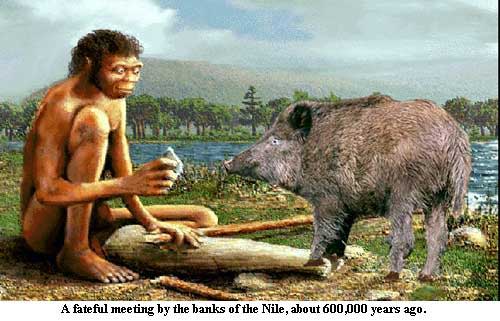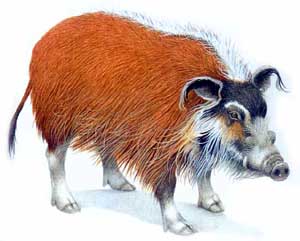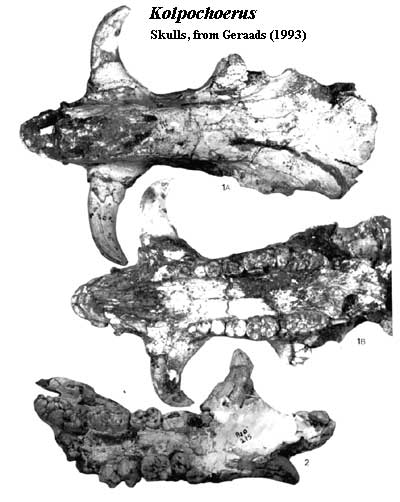 Sus
Sus| Cetartiodactyla | ||
| The Vertebrates | Suinae |
| Vertebrates Home | Vertebrate | Vertebrate |
|
Abbreviated Dendrogram
Laurasiatheria
├─Ferae
└─┬─Perissodactyla
│
└─Cetartiodactyla
├─Cetacea
│ ├─Pakicetidae
│ └─Autoceta
└─Artiodactyla
├─Suina
│ ├─Hippopotamidae
│ └─Suoidea
│ ├─Tayassuidae
│ └─Suinae
│ ├─Suini
│ │ └─Sus
│ └─┬─Potamochoerini
│ │ ├─Potamochoerus
│ │ └─Hylochoerus
│ └─Phacochoerini
│ └─Phacochoerus
└─Selenodontia
├─Camelidae
└─Ruminantia
├─Giraffoidea
└─┬─Bovoidea
└─Cervoidea
|
Contents
Overview |
The Suinae are the crown group of living pigs. There is very little agreement on the correct arrangement of the taxa within that simple definition. Cooke & Wilkinson [CW78] seem to favor special relationships between Sus and Potamochoerus on the one hand, and between Hylochoerus and Phacochoerus, on the other.
 Sus
SusThe genus Sus, and particularly the species Sus scrofus, deserves some special consideration because of the role it has played in human history. Both the genus and this particular species are actually rather unspecialized, basal citizens of the Suinae. Sus evolved in Asia, where it has a long fossil history. Numerous pig species have radiated from this hotbed of porcine evolution in Southeast Asia. Thus, several different waves of Sus reached Europe during the course of the Late Miocene, including S. scrofa. For some reason, it arrived in Africa rather late -- probably only in mid-Pleistocene times. Here it spread lightly over the North African plains, and penetrated the Nile Valley for some distance [CW78]. Here, we may be sure, on some fateful day about 600,000 years ago, a member of the genus Sus first encountered a member of the genus Homo. History does not record the outcome of this initial encounter between these two creatures of radically different design, but of similar disposition, habits and intellect. However, Sus disappears from Africa in Neolithic times [CW78].
 Suinae: crown group of living suids
Suinae: crown group of living suids
Range: from the Early Miocene of Europe & Asia [CW78], also reaching Africa in the Early Miocene [CW78]. Now cosmopolitan.
Phylogeny: Suidae :: Tetraconodontinae + * : Suini + (Potamochoerini + Phacochoerini).
Characters: medium-sized [CW78]; head long & pointed [CW78]; snout used in digging [CW78]; snout with terminal cartilaginous disk pierced by nares [CW78]; disk supported by unique rostral or prenasal bone [CW78]; C1 rounded to triangular cross-section, larger in males; canines directed outward & may curve dorsally [CW78]; C1 abraded across tips (honed with c1) [CW78]; molars primitively brachydont & bunodont [CW78]; molars may be specialized for grinding abrasive grasses; 3rd molars primitively with small talon/talonid [CW78]; tail short & thin, usually with terminal tuft of hair [CW78]; epipodials thin [CW78]; autopodia narrow, with 4 digits [CW78]; 2 central digits bear flattened hooves & are used in normal locomotion [CW78]; stomach simple except for cardiac pouch [CW78]; dorsal anal gland absent [CW78]; skin tough & thick [CW78]; 4+ mammary glands [CW78]; hair coarse and sometimes sparse [CW78]; often with knobs, warts & fenders on skull associated with male combat.
Image: a Weekly Warthog from HedWeb
Links: Suidae- Suinae Mikko's phylogeny); THE SUBORDER SUIFORMES.
References: Cooke & Wilkinson (1978) [CW78]. ATW040821.
Suini: Eumaiochoerus, Hippopotamodon, Korynochoerus (=Propotamochoerus?), Microstonyx.
Range: From the Middle Miocene of Southwest and South Asia, Europe. Sus replaces all others in Pliocene. Now cosmopolitan.
Phylogeny: Suinae : (Potamochoerini + Phacochoerini) + * : Sus
Characters: auditory canal angled >45º from horizontal [CW78]; premaxilla extends far posteriorly, to level of P4 [CW78]; infraorbital foramen located anteriorly, above P4 [CW78]; C1 with flattened oval cross-section [CW78]; canine flanges small [CW78]; P1 retained [CW78].
Links: SUINI Italian); GIORNATE DI PALEONTOLOGIA 2004 with abstract of succession of Suini in Europe).
References: Cooke & Wilkinson (1978) [CW78]. ATW040821.
Sus: S. scrofa
Range: from Late Miocene in Europe, Middle and Late Pleistocene only in North Africa (reintroduced in Holocene) [CW78]
Phylogeny: Suini : *.
Characters: skull elongate, pointed and flat from nasals to parietals [CW78]; parietal constriction narrow [CW78]; nuchal crest narrow [CW78]; nasals with flat sides [CW78]; canine flanges small [CW78]; zygoma narrow & not expanded laterally [CW78]; jaw articulation on level with top of foramen magnum [CW78]; jaw symphysis with spoon-shaped anterior section [CW78]; jaw constricted in c1-p2 diastema [CW78]; 3 prs of incisors [CW78]; canines relatively small[CW78];
References: Cooke & Wilkinson (1978) [CW78]. ATW040821.

 Potamochoerini: Celebochoerus, Kolpochoerus, Propotamochoerus
Potamochoerini: Celebochoerus, Kolpochoerus, Propotamochoerus
Range: From the Midle Miocene of South Asia, Russia & Europe. Presently restricted to equatorial Africa.
Phylogeny: Suinae :: Phacochoerini + * : Potamochoerus + Hylochoerus.
Characters: up to almost 2m long (Hylochoerus); zygomatic arch juts out perpendicularly (see Kolpochoerus image), at least in males [CW78]; ventral surface of zygomatic arch is slanted [CW78]; canines reduced [G93]; canine flanges with crest, at least in males [CW78]; all nocturnal?
Image: Potamochoerus porcus from СВИНЬИ И СВИНИНА
Links: Animal Diversity Web: Hylochoerus meinertzhageni: Information; Hylochoerus meinertzhageni; Giant forest hog; Chapter 4.1 - Action Plan; THE SUBORDER SUIFORMES; Kolpochoerus; Animal Diversity Web: Potamochoerus: Classification; ARTIODACTYLA; SUIDAE; POTAMOCHOERUS- African Bush Pig, or Red ...; The Bushpig - Potamochoerus porcus of Southern Africa; Comparative Placentation > Red River Hog; Estudios Geológicos, vol.55 (5-6), 1999;
References: Cooke & Wilkinson (1978) [CW78]; Geraads (1993) [G93]. ATW040821.
Potamochoerus:P. porcus (bush pig or river hog)
Range: from the Late Pleistocene of sub-Saharan Africa & Madagascar
Phylogeny: Potamochoerini : Hylochoerus + *.
Characters: skull long & narrow [CW78]; skull elongate, pointed and flat from nasals to parietals [CW78]; parietal constriction narrow [CW78]; nasals bulge above canine flanges, with expanded rugose area in males [CW78]; canine flanges large, with elevated lateral crest [CW78]; zygoma juts out sharply & may be inflated in males [CW78]; jaw articulation on level with top of foramen magnum [CW78]; jaw symphysis with spoon-shaped anterior section [CW78]; small shelf posterior to symphysis [CW78]; jaw constricted in c1-p2 diastema [CW78]; dentition simple & brachydont [CW78]; 3 prs incisors [CW78]; canines relatively small [CW78]; forest & woodlands near rivers [CW78].
References: Cooke & Wilkinson (1978) [CW78].
Hylochoerus: H. meinertzhageni ("giant" forest hog)
Range: no fossil record?
Potamochoerini : Potamochoerus+ *.
Characters: large animal; parietal area wide and concave between orbits [CW78]; zygoma robust & expanded, with inflated area of hollow bone [CW78]; jaw articulation more ventral than top of foramen magnum [CW78]; occiput wide [CW78]; jaw symphysis anterior border rather square [CW78]; 1 pair of small incisors shed in adults) [CW78]; canines flare broadly outward [CW78]; premolars reduced [CW78];
References: Cooke & Wilkinson (1978) [CW78].
Phacochoerini: Metridiochoerus, Potamochoeroides.
Range: Metridiochoerus from Late Pliocene of Africa
Phylogeny: Suini :: Potamochoerini + * : Phacochoerus.
Characters: orbits elevated above fronto-parietal surface [CW78]; origin of m. levator rostri elongate & triangular [CW78]; C1 without enamel in adults C1 curves upward [CW78]; C1 curves upward [CW78]; canine flanges large & tubular [CW78]; jaw motion adapted for orthal grinding [CW78].
Links: JVP Content; The right lower third molar of Metridiochoerus andrewsi; Chapter 1- Action Plan; Animal Diversity Web: Phacochoerus: Classification; Genus Phacochoerus; Taxonomic history of the genus Phacochoerus; Phacochoerus africanus; species of Phacochoerus; HerbWeb's Warthog of the Week.
References: Cooke & Wilkinson (1978) [CW78].
Phacochoerus: P. africanus (wart hog)
Range: from the Pleistocene of Africa [CW78].
Phylogeny: Phacochoerini : *.
Characters: frontal area very broad & flat between orbits [CW78]; orbits strongly elevated [CW78]; maxilla tall (accommodates M3) [CW78]; orbits posterior [CW78]; zygoma root is raised, but makes only small angle with cheek [CW78]; jugal flares laterally and forms bosses in males [CW78]; jaw articulation more dorsal than top of foramen magnum [CW78]; occipital condyles elevated above palatal plane [CW78]; jaw symphysis anterior border rather square [CW78]; 1 pair of small incisors [CW78]; premolars reduced [CW78]; M/m3 strongly hypsodont [CW78]; skin of face thickened to form characteristic "warts" [CW78].
References: Cooke & Wilkinson (1978) [CW78].
checked ATW040705